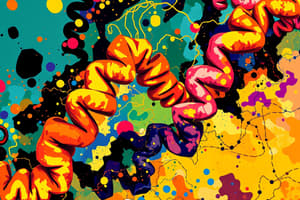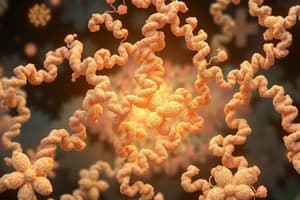Podcast
Questions and Answers
Which type of carbohydrate consists of 3 to 100 monosaccharides?
Which type of carbohydrate consists of 3 to 100 monosaccharides?
- Oligosaccharides (correct)
- Monosaccharides
- Disaccharides
- Polysaccharides
What is the most common type of polysaccharide found in cell walls?
What is the most common type of polysaccharide found in cell walls?
- Glycogen
- Starch
- Chitin
- Cellulose (correct)
What is the stored form of glucose in the body?
What is the stored form of glucose in the body?
- Glycogen (correct)
- Chitin
- Cellulose
- Starch
What type of molecule is a glycoprotein?
What type of molecule is a glycoprotein?
Which of the following blood types refers to a combination of glycoproteins attached to red blood cells?
Which of the following blood types refers to a combination of glycoproteins attached to red blood cells?
Which carbohydrate is used in manufacturing surgical thread due to its flexibility and biodegradability?
Which carbohydrate is used in manufacturing surgical thread due to its flexibility and biodegradability?
What is the function of glycoproteins in the body?
What is the function of glycoproteins in the body?
Which type of proteins control all the activities of life within cells?
Which type of proteins control all the activities of life within cells?
What distinguishes each amino acid from one another?
What distinguishes each amino acid from one another?
What type of reaction connects amino acids to form a peptide bond?
What type of reaction connects amino acids to form a peptide bond?
What determines all subsequent structural levels of a polypeptide chain?
What determines all subsequent structural levels of a polypeptide chain?
Which type of bond results from hydrogen bonds between parts of the polypeptide chain?
Which type of bond results from hydrogen bonds between parts of the polypeptide chain?
What are chains with fewer amino acids called?
What are chains with fewer amino acids called?
How many linked amino acids form a tripeptide bond?
How many linked amino acids form a tripeptide bond?
When is a polypeptide chain considered a protein?
When is a polypeptide chain considered a protein?
What is the function of insulin in the body?
What is the function of insulin in the body?
What is the primary function of a protein?
What is the primary function of a protein?
Which component is part of the tertiary structure of a protein?
Which component is part of the tertiary structure of a protein?
What causes denaturation of proteins?
What causes denaturation of proteins?
What is the quaternary structure of a protein based on?
What is the quaternary structure of a protein based on?
Which nitrogenous base is found in RNA but not in DNA?
Which nitrogenous base is found in RNA but not in DNA?
What is the primary difference between DNA and RNA at the sugar level?
What is the primary difference between DNA and RNA at the sugar level?
'Loss of function' in proteins can most likely occur due to:
'Loss of function' in proteins can most likely occur due to:
'Quaternary Structure' refers to the shape arising from interactions between:
'Quaternary Structure' refers to the shape arising from interactions between:
What is the main function of DNA?
What is the main function of DNA?
Which nitrogenous bases are present in DNA but not in RNA?
Which nitrogenous bases are present in DNA but not in RNA?
What type of bond is responsible for the hydrophobic nature of lipids?
What type of bond is responsible for the hydrophobic nature of lipids?
Which group does Triglyceride belong to among the three groups of lipids mentioned?
Which group does Triglyceride belong to among the three groups of lipids mentioned?
What is the backbone of a triglyceride molecule?
What is the backbone of a triglyceride molecule?
How are lipids produced in cells?
How are lipids produced in cells?
What characterizes unhealthy foods in terms of fat content?
What characterizes unhealthy foods in terms of fat content?
How are saturated fatty acids defined in terms of hydrogen content?
How are saturated fatty acids defined in terms of hydrogen content?
What type of consistency do unsaturated fatty acids have at room temperature?
What type of consistency do unsaturated fatty acids have at room temperature?
Why is cholesterol considered a key component of animal cell membranes?
Why is cholesterol considered a key component of animal cell membranes?
How do saturated fats contribute to increasing cholesterol levels in the body?
How do saturated fats contribute to increasing cholesterol levels in the body?
Which type of lipid is characterized by being combined with alcohols or other hydrocarbons, forming a stiff, water-repellent material?
Which type of lipid is characterized by being combined with alcohols or other hydrocarbons, forming a stiff, water-repellent material?
What is the main difference between saturated and unsaturated fatty acids?
What is the main difference between saturated and unsaturated fatty acids?
In what way do steroids differ from waxes?
In what way do steroids differ from waxes?
What role does an unhealthy diet play in contributing to high cholesterol levels?
What role does an unhealthy diet play in contributing to high cholesterol levels?
How do monosaccharides differ from polysaccharides?
How do monosaccharides differ from polysaccharides?
Flashcards are hidden until you start studying
Study Notes
Carbohydrates
- Oligosaccharides consist of 3 to 100 monosaccharides.
- Cellulose is the most common polysaccharide found in plant cell walls.
- Glycogen is the stored form of glucose in the body.
Glycoproteins
- Glycoproteins are molecules composed of carbohydrates and proteins.
- The blood type AB refers to a combination of glycoproteins on red blood cells.
- Surgical thread is commonly made from cellulose due to its flexibility and biodegradability.
- Glycoproteins function in cell recognition, signaling, and immune responses.
Proteins
- Regulatory proteins control essential activities within cells.
- Amino acids are distinguished from one another by their unique R groups/side chains.
- Dehydration synthesis is the reaction that connects amino acids to form peptide bonds.
- The sequence of amino acids determines all subsequent structural levels of a polypeptide chain.
- Hydrogen bonds are responsible for secondary structural shapes in polypeptides.
- Chains with fewer than 50 amino acids are referred to as peptides.
- A tripeptide consists of three linked amino acids.
- A polypeptide chain is considered a protein when it achieves a functional structure, usually over 50 amino acids in length.
- Insulin regulates blood sugar levels by promoting glucose uptake in cells.
- The primary function of proteins includes catalyzing biochemical reactions and providing structure.
- The tertiary structure of a protein involves the overall three-dimensional folding, influenced by interactions between R groups.
- Proteins can become denatured due to extreme temperature or pH changes, disrupting their structure and function.
Nucleic Acids
- The quaternary structure of a protein arises from interactions between multiple polypeptide chains.
- Uracil is the nitrogenous base found in RNA but not in DNA.
- The primary difference between DNA and RNA at the sugar level is the presence of ribose in RNA and deoxyribose in DNA.
Lipids
- 'Loss of function' in proteins can most likely occur due to denaturation.
- 'Quaternary Structure' refers to the shape arising from the interactions between multiple protein subunits.
- The main function of DNA is to store and transmit genetic information.
- Adenine, thymine, cytosine, and guanine are nitrogenous bases present in DNA but not in RNA.
- Hydrophobic interactions and van der Waals forces are responsible for the hydrophobic nature of lipids.
- Triglycerides belong to the lipid group known as fats or oils.
- The backbone of a triglyceride molecule consists of glycerol.
- Lipids are produced in cells through metabolic pathways involving fatty acid synthesis.
- Unhealthy foods are typically characterized by high levels of saturated fats and trans fats.
- Saturated fatty acids are defined by having the maximum number of hydrogen atoms and no double bonds in their carbon chains.
- Unsaturated fatty acids are generally liquid at room temperature due to their double bonds causing kinks.
- Cholesterol is considered a key component of animal cell membranes, providing fluidity and stability.
- Saturated fats contribute to increasing cholesterol levels by promoting the formation of low-density lipoprotein (LDL).
- Waxes are classified as lipids that combine with alcohols or hydrocarbons, forming a stiff, water-repellent material.
- The main difference between saturated and unsaturated fatty acids lies in the presence of double bonds in unsaturated fats.
- Steroids differ from waxes in structure and function; steroids are four fused carbon rings, while waxes are long-chain fatty acids.
- An unhealthy diet can contribute to high cholesterol levels by increasing saturated and trans fat intake.
- Monosaccharides are simple sugars, while polysaccharides are complex carbohydrates composed of many sugar units.
Studying That Suits You
Use AI to generate personalized quizzes and flashcards to suit your learning preferences.




